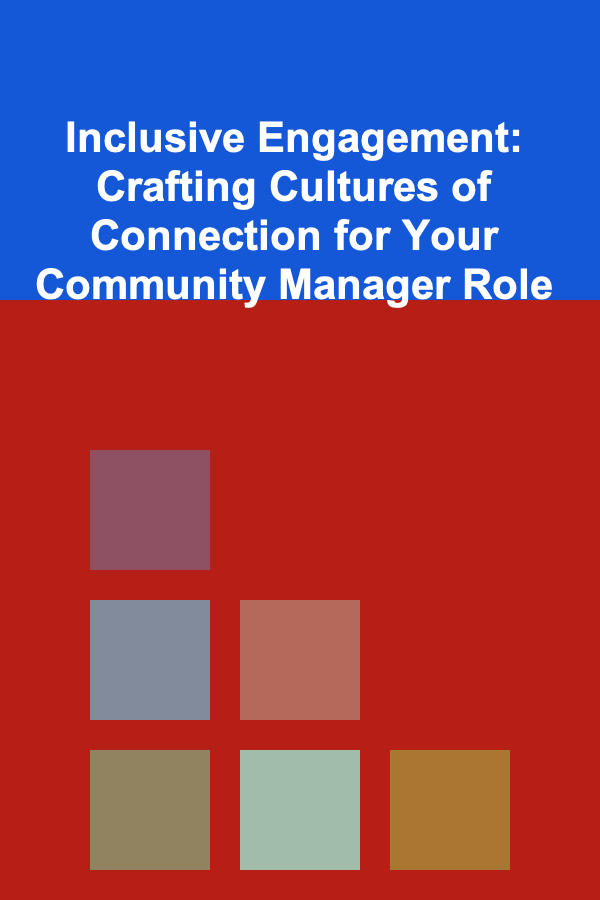
Inclusive Engagement: Crafting Cultures of Connection for Your Community Manager Role
ebook include PDF & Audio bundle (Micro Guide)
$12.99$11.99
Limited Time Offer! Order within the next:

In today's interconnected world, community management plays a pivotal role in fostering meaningful connections between individuals, brands, and organizations. As the bridge between the audience and the organization, community managers are responsible for creating environments that are not only engaging but also inclusive.
Inclusive engagement is a powerful tool for building communities that are both diverse and united. When community managers prioritize inclusivity, they cultivate spaces where people of all backgrounds feel valued and heard. In this guide, we'll explore how to craft cultures of connection that embrace diversity, inclusivity, and engagement, allowing you to thrive in your role as a community manager.
The Importance of Inclusive Engagement
Inclusive engagement is more than just a buzzword; it's an essential approach for modern community management. When communities are inclusive, they foster a sense of belonging, trust, and shared values. Here's why it matters:
1. Enhances Relationship Building
Inclusive engagement encourages open communication and mutual respect. When people feel respected and heard, they're more likely to contribute meaningfully to discussions, share ideas, and connect with others.
2. Fosters Diverse Perspectives
Inclusive environments encourage participation from individuals of different backgrounds, which brings a wealth of perspectives to the table. This diversity leads to more creative solutions, improved decision-making, and a richer community experience.
3. Boosts Retention and Growth
When people feel included, they're more likely to stay engaged with the community. Inclusivity fosters loyalty and encourages members to invite others to join, leading to organic community growth.
4. Improves Brand Reputation
Communities built on inclusivity reflect positively on the brand or organization they represent. Demonstrating a commitment to diversity and inclusion enhances your organization's reputation, making it an attractive place for people who value these principles.
Key Principles for Crafting Inclusive Engagement
As a community manager, it's crucial to build an inclusive engagement strategy that reflects the values of your community and organization. Here are the key principles to guide you in fostering a culture of connection.
1. Embrace Diversity in All Forms
A truly inclusive community embraces diversity not just in terms of ethnicity, gender, and age, but also in values, ideas, and experiences. Diversity should be reflected in your community's content, events, and discussions. Here's how to do it:
- Create diverse content: Ensure that the content you share addresses different interests, backgrounds, and needs. Include various viewpoints and voices to appeal to a broad audience.
- Encourage multiple perspectives: When hosting discussions or events, ensure that there is space for diverse opinions. This could mean actively inviting people from underrepresented groups or setting up discussion threads that explore different cultural viewpoints.
- Respect cultural differences: Take the time to understand cultural nuances and avoid making assumptions about your community members. Being mindful of different holidays, traditions, and values can help prevent unintentional exclusion.
2. Foster Open and Respectful Communication
The way you communicate with your community sets the tone for how others will engage. Clear, respectful, and empathetic communication is key to creating an inclusive atmosphere. Here's how to encourage this:
- Active listening: Make sure to listen to your community members, especially those from underrepresented or marginalized groups. Show that you value their input by acknowledging their contributions and providing thoughtful feedback.
- Promote respectful dialogue: Encourage members to engage in conversations that are respectful and free from harassment. Set clear community guidelines that emphasize kindness, respect, and inclusivity, and enforce them consistently.
- Be transparent: Be open and transparent with your community about your goals, decisions, and challenges. Trust is the foundation of any healthy community, and fostering an environment where members feel they are informed and included builds that trust.
3. Make Space for Vulnerability and Empathy
Building connections goes beyond surface-level interactions. It's about creating a safe space where people can express their true selves without fear of judgment. Here's how to achieve this:
- Share personal stories: As a community manager, you can lead by example. Share your personal experiences and struggles, especially those related to overcoming adversity or navigating complex issues. Vulnerability fosters empathy and connection.
- Provide emotional support: Sometimes, community members may seek emotional support. Be prepared to listen, provide resources, and guide individuals who may need help. Showing empathy strengthens relationships and creates a supportive community.
- Normalize open discussions: Encourage conversations about mental health, self-care, and personal growth. By making these topics a regular part of your community, you normalize vulnerability and make members feel more connected to one another.
4. Ensure Accessibility for All
Inclusivity means ensuring that every community member, regardless of their abilities or circumstances, can fully participate. This requires taking steps to make your community accessible to a wide range of people.
- Consider disabilities: Make sure that your community platform is accessible to people with disabilities. This could include providing captions for videos, ensuring that your website is screen reader-friendly, or providing alternative text for images.
- Accommodate diverse time zones: When organizing events, make sure to offer options that accommodate different time zones or provide recorded content for those who can't participate in real-time.
- Offer different modes of communication: Not everyone communicates the same way. Some may prefer text, while others may want to use voice or video. Offering diverse ways to engage ensures that everyone can participate in a manner they're comfortable with.
5. Celebrate and Recognize All Contributions
Acknowledging and celebrating every community member's contributions fosters a sense of belonging. Recognition doesn't always have to be grand; small, everyday acknowledgments can go a long way.
- Highlight diverse members: Showcase community members from different backgrounds and experiences. Share their stories, highlight their achievements, and give them the recognition they deserve.
- Celebrate milestones: Whether it's a birthday, an achievement, or a special cultural event, take the time to celebrate personal milestones and community successes. This shows your members that you see them as individuals, not just part of a collective.
- Encourage peer recognition: Create systems where community members can recognize each other's contributions. This could include shoutouts, awards, or simple messages of thanks. Peer recognition strengthens the bonds within the community.
6. Maintain Consistency in Engagement
Building an inclusive community doesn't happen overnight. Consistency is key to maintaining the trust and engagement of your members. Here's how to ensure that your inclusive engagement efforts remain steady:
- Keep the conversation going: Regularly interact with your community members through posts, events, and discussions. Your consistent presence shows that you are committed to building an inclusive culture.
- Monitor and adjust: Continuously assess how your community is engaging with your inclusivity efforts. Are certain groups being left out? Are there barriers to participation? Don't be afraid to make adjustments based on feedback and evolving needs.
- Provide ongoing training: Stay updated on best practices for diversity and inclusion. This includes educating yourself and your team on new tools, resources, and strategies for maintaining inclusivity within your community.
Conclusion
As a community manager, your role goes beyond overseeing interactions; you are a cultural architect who shapes the values, behaviors, and experiences of your community. Crafting a culture of inclusive engagement takes time, effort, and intention, but the rewards are immense. By fostering environments that are diverse, respectful, empathetic, accessible, and consistent, you will create strong, connected communities where everyone feels seen, heard, and valued.
Inclusion is not just a one-time effort but a continuous process. The more you prioritize inclusive engagement, the more your community will flourish. With your leadership, your community can become a powerful, positive force that brings people together from all walks of life, united by shared goals, experiences, and connections.

How to Organize Your Kitchen Cabinets for Maximum Storage Capacity
Read More
The Art of Architecture: Techniques for Creating Sustainable and Aesthetic Designs
Read More
How to Play the Trumpet: Embouchure and Breathing
Read More
How to Make Your Own Healthy Snacks for On-the-Go
Read More
Understanding POD Providers: A Deep Dive
Read More
10 Tips for Building a Consistent Forex Trading Routine
Read MoreOther Products

How to Organize Your Kitchen Cabinets for Maximum Storage Capacity
Read More
The Art of Architecture: Techniques for Creating Sustainable and Aesthetic Designs
Read More
How to Play the Trumpet: Embouchure and Breathing
Read More
How to Make Your Own Healthy Snacks for On-the-Go
Read More
Understanding POD Providers: A Deep Dive
Read More